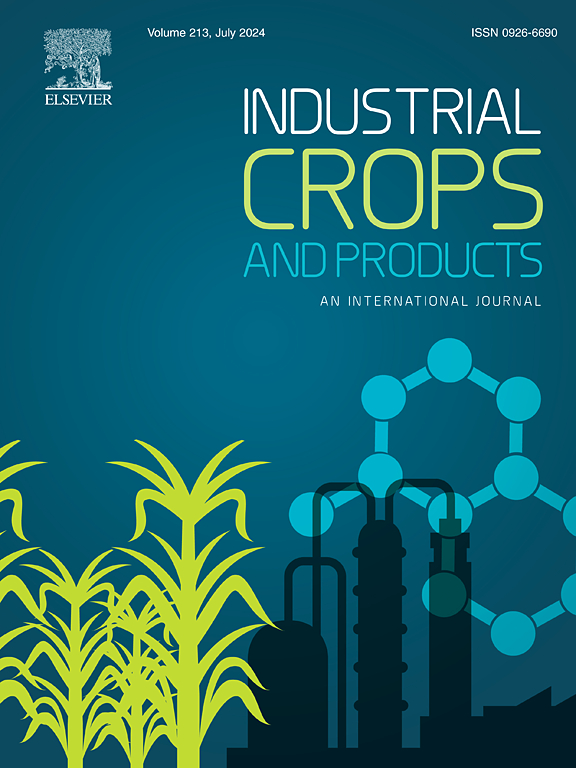Triclosan removal from synthetic solution using corn cobs and their magnetic composites: Insights from batch adsorption and fixed-bed column studies
IF 5.6
1区 农林科学
Q1 AGRICULTURAL ENGINEERING
引用次数: 0
Abstract
Triclosan, a lipophilic contaminant and endocrine disruptor, is widely detected in industrial, pharmaceutical, and domestic wastewaters. Organic residues impregnated with nanoparticles could be efficient adsorbents for such contaminants. This study evaluated the efficiency of corn cobs (CC), iron oxide (IO), and their magnetic composites in removing triclosan (30 mg L−1) using batch and fixed-bed column tests. Adsorbents were characterized by analytical (ASTM standards), instrumental (microscopy, spectroscopy, BET, X-ray diffraction), and computational methods. Batch tests analyzed CC/IO/composite doses (0.001–2.5 g L−1), contact times (2.5–60 min), and CC ratios (1:1, 2:1, 4:1). Results fit kinetic and isothermal models. Fixed-bed columns used CC and 4CC:1IO (most efficient). CC contained ∼94.2 % lignocellulosic material, an irregular surface with 0.4 m² g−1, and functional groups (OH, C![]() O, C-O-H). IOs (∼15 nm) had a surface area of 66.3 m²/g, while composites ranged from 1.4 to 2.2 m² g−1. Optimal doses were 2.0 g L−1 for CC and 3.75–25-fold for IO/composites, removing 84.7–94.1 % triclosan within 40–60 min. Data fit the pseudo-second order model (R² = 0.89–0.99) and isotherms aligned with Langmuir and Sips models (R² = 0.97–0.99). In fixed-bed columns, CC and 4CC:1IO reached saturation at 700 and 1250 min, respectively, fitting the Bohart-Adams model (R² = 0.93–0.98). Computational chemistry elucidated triclosan removal mechanisms related to its lipophilicity, solubility, and reactive lignocellulosic sites. CC and their composites are effective, sustainable, and low-cost alternatives for removing triclosan and other lipophilic emerging contaminants, with potential for broader water treatment applications. This study evaluated the adsorption capacity of the materials for triclosan removal, incorporating kinetic models, breakthrough curves, and computational simulations to understand the removal mechanisms.
O, C-O-H). IOs (∼15 nm) had a surface area of 66.3 m²/g, while composites ranged from 1.4 to 2.2 m² g−1. Optimal doses were 2.0 g L−1 for CC and 3.75–25-fold for IO/composites, removing 84.7–94.1 % triclosan within 40–60 min. Data fit the pseudo-second order model (R² = 0.89–0.99) and isotherms aligned with Langmuir and Sips models (R² = 0.97–0.99). In fixed-bed columns, CC and 4CC:1IO reached saturation at 700 and 1250 min, respectively, fitting the Bohart-Adams model (R² = 0.93–0.98). Computational chemistry elucidated triclosan removal mechanisms related to its lipophilicity, solubility, and reactive lignocellulosic sites. CC and their composites are effective, sustainable, and low-cost alternatives for removing triclosan and other lipophilic emerging contaminants, with potential for broader water treatment applications. This study evaluated the adsorption capacity of the materials for triclosan removal, incorporating kinetic models, breakthrough curves, and computational simulations to understand the removal mechanisms.

求助全文
约1分钟内获得全文
求助全文
来源期刊

Industrial Crops and Products
农林科学-农业工程
CiteScore
9.50
自引率
8.50%
发文量
1518
审稿时长
43 days
期刊介绍:
Industrial Crops and Products is an International Journal publishing academic and industrial research on industrial (defined as non-food/non-feed) crops and products. Papers concern both crop-oriented and bio-based materials from crops-oriented research, and should be of interest to an international audience, hypothesis driven, and where comparisons are made statistics performed.
 求助内容:
求助内容: 应助结果提醒方式:
应助结果提醒方式:


